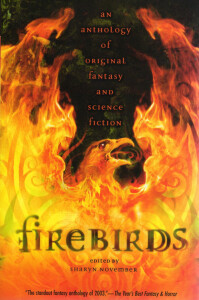 GMR’s Editor in Chief, Cat Eldridge, is a wicked, wicked man. He e-mailed me the other day to say, “Firebirds, the new anthology from Sharyn November, just came in. Let’s get it reviewed fast!”
GMR’s Editor in Chief, Cat Eldridge, is a wicked, wicked man. He e-mailed me the other day to say, “Firebirds, the new anthology from Sharyn November, just came in. Let’s get it reviewed fast!”
“Fine,” I replied. “I’ve got a couple of reviewers I can ask. I’ll let you know as soon as I’ve found someone.”
“OK,” he said. “In the meantime, I’ll just send one of the extra review copies we received over to your office so you can take a look at it.”
It came. I looked at the list of authors, noted the subtitle: “Original Fantasy and Science Fiction …” I e-mailed Cat. “I’ll review it myself,” I said.
He wrote back with a laugh. “I thought you would, once you saw it.” He knows me too well.
As GMR’s book review editor, it’s my job to make sure all the pirates on the crew here get their fair share of the loot — err, that is, it’s my job to see that the books we receive for review get spread around evenly amongst the reviewers, and that folks who are especially knowledgeable in particular areas get the right books sent their way. I try to do my job fairly and well, and not let anyone get too many of the best gems we score. But this time, I admit that I acted with utmost greed and entirely in my own self-interest.
Throw stones at me if you dare! This anthology, unlike many if not most anthologies that are published, is made up of entirely new, never before published stories. Completely fresh, still photosynthesizing, text. It makes me drool. And the contributors! Egad! I just have to list them all for you. All seventeen.
Delia Sherman, Megan Whalen Turner, Sherwood Smith, Nancy Springer, Lloyd Alexander, Meredith Ann Pierce, Michael Cadnum, Emma Bull, Charles Vess (Charles Vess!), Patricia A. McKillip, Kara Dalkey, Garth Nix, Elizabeth E. Wein, Diana Wynne Jones, Nancy Farmer, Nina Kiriki Hoffman, and Laurel Winter.
The list reads like a role call in a future Valhalla of the Greatest Writers on Earth. I was about to say that Sharyn November is a goddess to be able to assemble original fiction by all of these folks inside one set of covers. But she’s something even better. She’s a great editor who knows almost everyone, and she has great ideas — like the Firebird imprint — that make writers willing to give her what she asks for.
Which in this case is a fantastic collection of stories. Yes, I’m gushing, I know it. But in all honesty, there isn’t a mediocre offering in the lot. I’ve got my favorites, to be sure. I’ve never been disappointed by Patricia McKillip, and she’s wonderful here, once again. “Byndley” is a story about a man who managed to steal something from Faerie years ago. Now he wants to return it, but he can’t find the way back in … McKillip must have inherited (or found) George MacDonald’s grammarie: she excels, as did he, at portraying Faerie as a place not just beautiful, or dangerous, or intoxicating, but other. Her fey are indeed beautiful, and I long for them. But most of all, I realize how completely fey — not human — they are. Their motivations aren’t mine, aren’t those of anyone I’ve ever encountered.
Another one I just love is the first of its type I’ve seen in a short story anthology. It’s a graphic short story, by Emma Bull and Charles Vess. Bull writes the lucid text, adapted from the traditional ballad “The Black Fox.” Vess enhances, counters and enchants the story with his drawings, lucid in their own right. The result is more than a picture, more than a written story. Neil Gaiman may have popularized the idea of the graphic novel as “real lit-ruh-chuh,” but he’s not the only one who can do it. The form shines here.
Diana Wynne Jones tells “Little Dot,” a story about a magician from the point of view of the cat who owns him. Any readers who are owned by cats will relate to this story. Lloyd Alexander’s eerie “Max Mondrosch” is almost the exact reverse of Bartleby the Scrivener. Max wants a job. Really wants one. He applies everywhere, but he’s “just not right” for any job. The story makes me shiver, and not just because I’ve got to go job-hunting soon.
The stories vary widely, naturally. “Fantasy and Science Fiction” is a broad valley, and just when you think you’ve explored all of it, the horizon retreats and you realize the mountains you almost reached were a mirage. A couple of the stories here may not even seem like science fiction or fantasy to some readers. “Max Mondrosch” has no “magic,” no “science.” But it works on your imagination like a spell, snaring you. And it ends in a surreal twilight. “Chasing the Wind” is a story by Elizabeth E. Wein, who says she started out writing in her quasi-historical world of sixth-century Ethiopia, but realized that she really wanted to write about AEROPLANES. Aeroplanes are, um, science. Right?
“The Lady of the Ice Garden,” by Kara Dalkey, is yet another variation on Hans Christian Andersen’s “The Snow Queen,” this one set in Samurai Japan. It shows that fairy tales are a truly inexhaustible source, forever spinning out new ideas, new characters, new settings, as various as snow flakes. “The Baby in the Night Deposit Box” by Megan Whelan Turner and “Hope Chest” by Garth Nix are two “modern” stories that mix magic with our own industrial, technological world in ways that are comical and tragical.
You have to read them all. Of course, you know that.
(Firebird, 2003)
